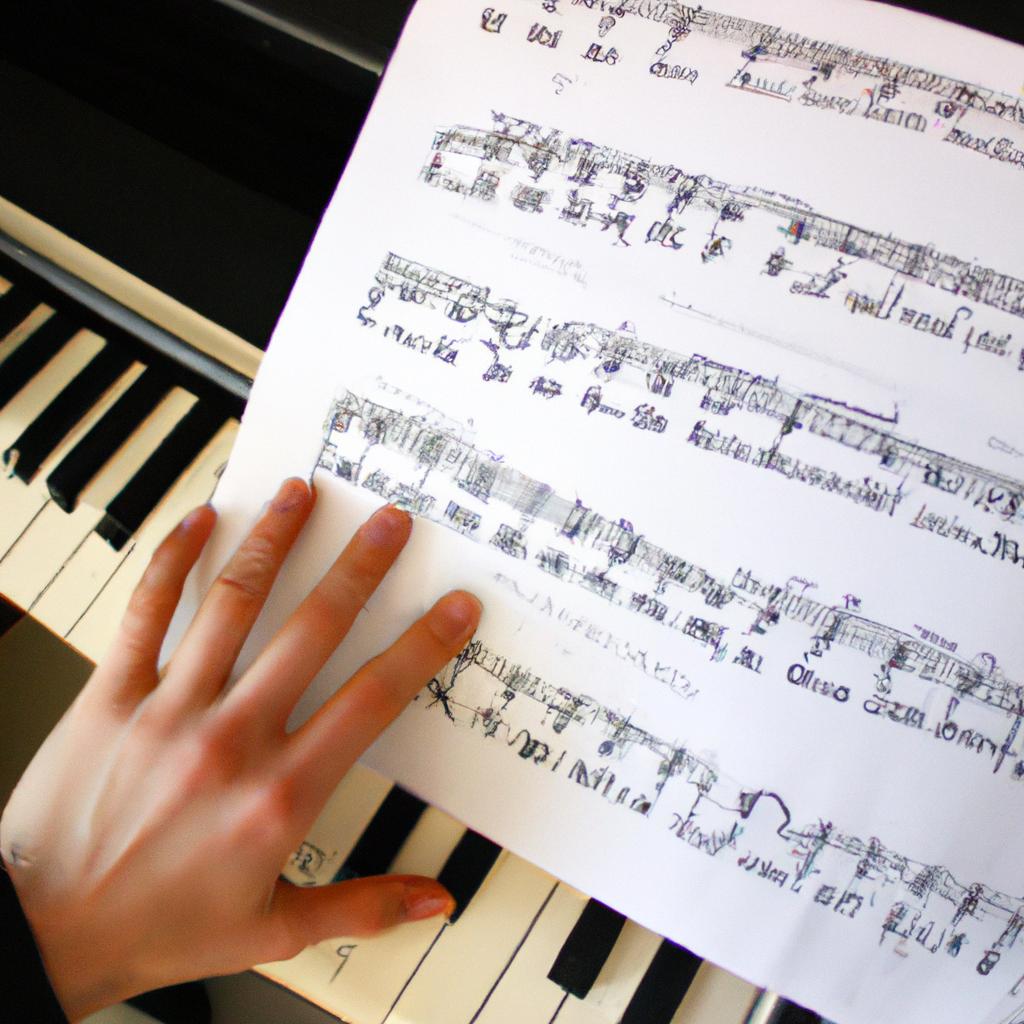Understanding scales is an essential component of music theory, enabling musicians to create harmonically pleasing compositions. Jose Carlos Matos, a renowned music theorist and composer, has made significant contributions in this field through his insightful perspectives on scales. This article aims to explore Matos’ unique insights into the world of music theory, shedding light on how he revolutionized our understanding of scales and their applications.
To illustrate the impact of Matos’ theories, let us consider the case study of a fictional jazz pianist named Sarah. Before encountering Matos’ work, Sarah primarily relied on traditional Western tonalities and modes while improvising over jazz standards. However, she found herself longing for new ways to express her musical ideas and break free from predictable harmonic patterns. It was then that she delved into Matos’ writings and discovered a whole new universe of scale possibilities.
Matos challenged conventional notions by introducing the concept of non-traditional scales derived from mathematical algorithms or cultural traditions outside the Western canon. Through studying these alternative scales, Sarah began incorporating exotic sounds into her improvisations, injecting fresh vibrancy into her performances. Inspired by Matos’ groundbreaking ideas, she embraced experimentation with various scale structures and gradually developed her own distinctive voice as a jazz musician.
The Importance of Learning Scales
Imagine a guitarist named Sarah, who has been playing for several years and is proficient in various musical genres. However, when she attempts to improvise or compose her own music, she feels limited by her lack of understanding scales. This scenario highlights the significance of learning scales as a fundamental aspect of music theory.
Learning scales provides musicians with a solid foundation upon which they can build their musical knowledge and skills. Firstly, scales serve as a framework that organizes the notes within an octave, providing structure and coherence to musical compositions. They establish tonal relationships between different pitches and allow musicians to create melodies, harmonies, and chords that are aesthetically pleasing.
Moreover, mastering scales expands one’s ability to express emotions through music. By familiarizing oneself with various scales such as major, minor, pentatonic, or blues scale, musicians gain access to a wide range of sonic colors and moods. For example:
- Major scale: Conveys feelings of happiness and joy.
- Minor scale: Evokes melancholy or sadness.
- Pentatonic scale: Creates a sense of simplicity and tranquility.
- Blues scale: Expresses raw emotion and intensity.
Understanding these emotional nuances enables musicians to convey specific messages or evoke certain responses from their audience effectively.
To better illustrate the importance of learning scales visually, consider the following table:
| Scale Type | Characteristics | Emotional Impact |
|---|---|---|
| Major | Bright sound | Joyful |
| Minor | Darker sound | Melancholic |
| Pentatonic | Simplified | Calming |
| Blues | Edgy | Intense |
This table showcases how each type of scale possesses unique characteristics that influence the emotional impact on listeners. By exploring different types of scales, musicians can craft their compositions with precision while capturing the desired mood or atmosphere.
In summary, learning scales is crucial for musicians seeking to enhance their musical repertoire. It provides a solid foundation for composition and improvisation while offering a diverse range of emotional expressions.
Different Types of Scales
Understanding Scales: Exploring Jose Carlos Matos’ Music Theory Insights
Transitioning from the previous section on the importance of learning scales, let us now delve deeper into different types of scales. To illustrate their significance in music theory, we will explore a hypothetical case study involving a budding pianist named Emily.
Emily’s journey as a musician began with her understanding of major and minor scales – the fundamental building blocks of Western music. She soon realized that these two types of scales formed the basis for countless melodies and harmonies across various genres. With this newfound knowledge, Emily embarked on a quest to discover more about the intricacies of scales and how they contribute to musical expression.
As she delved further into her studies, Emily encountered an array of fascinating scale variations beyond just major and minor. These included exotic scales like the pentatonic, blues, and whole-tone scales. Each scale brought forth its unique tonal qualities, evoking distinct emotions within listeners. For instance:
- The pentatonic scale conveyed a sense of tranquility and simplicity.
- The blues scale stirred up feelings of melancholy and longing.
- The whole-tone scale created an ethereal atmosphere filled with uncertainty and anticipation.
- The harmonic minor scale infused compositions with a touch of mystique and tension.
To better understand these emotional nuances associated with different scales, refer to the following table:
| Scale Type | Emotional Response |
|---|---|
| Major | Joyful |
| Minor | Melancholic |
| Pentatonic | Peaceful |
| Blues | Soulful |
By exploring various types of scales through her studies, Emily discovered that each one had its distinct character and mood-setting abilities. This insight opened up new avenues for creative exploration in her compositions.
In our next section on “How Scales are Constructed,” we will discuss the underlying principles behind scale construction and unveil some of the secrets behind Jose Carlos Matos’ approach to composing. Through this exploration, we will gain a deeper understanding of how scales form the backbone of musical compositions and lay the foundation for captivating melodies. Stay tuned as we embark on this fascinating journey into the world of scale construction.
Note: The transition sentence should be written accordingly based on the subsequent section about “How Scales are Constructed.”
How Scales are Constructed
Understanding Scales: Exploring Jose Carlos Matos’ Music Theory Insights
Section 3: Unveiling the Musical Applications of Different Types of Scales
In order to comprehend the true depth and versatility of scales, let us examine an example that showcases their practical application. Imagine a composer named Anna who wants to create a sense of melancholy in her composition. She decides to use the Dorian scale, which is known for its haunting and introspective qualities. By incorporating this scale into her melody, Anna effectively captures the desired emotional tone.
To fully appreciate the significance of different types of scales, consider the following points:
- Expressive Range: Each type of scale offers a unique palette of sounds, allowing musicians to evoke specific emotions or moods within their compositions.
- Cultural Significance: Scales hold cultural significance across various musical traditions worldwide, reflecting diverse historical contexts and artistic expressions.
- Exploration and Experimentation: Musicians often explore unconventional scales as a means of pushing creative boundaries and adding innovative elements to their music.
- Harmonic Interplay: The relationship between scales and chords plays a fundamental role in harmonizing melodies and creating rich tonal landscapes.
Let us delve further into these aspects by examining a table that highlights some common types of scales along with their characteristic traits:
| Scale Type | Characteristics | Emotional Tone |
|---|---|---|
| Major | Bright, happy | Joyful |
| Minor | Melancholic | Sadness |
| Blues | Soulful | Gritty |
| Pentatonic | Mystical | Serenity |
As we can see from the table above, each scale possesses distinct characteristics that elicit specific emotional responses from both performers and listeners alike.
By appreciating the expressive range offered by different types of scales, composers like Anna can effectively craft compositions that resonate deeply with their intended audience. In the subsequent section, we will explore how scales and chords interact to create harmonically complex musical landscapes that are both captivating and mesmerizing.
The Relationship between Scales and Chords
Understanding Scales: Exploring Jose Carlos Matos’ Music Theory Insights
Section H2: The Relationship between Scales and Chords
In our exploration of scales, we have learned how they are constructed. Now let us delve deeper into the relationship between scales and chords, which plays a crucial role in music theory. To illustrate this connection, let’s consider an example where we examine the key of C major.
Imagine you are playing a chord progression in the key of C major on a piano. As you progress from one chord to another, you may notice that each chord seems to be derived from the notes within the C major scale. This is not a coincidence but rather a result of the harmonization process. When constructing chords, musicians often select specific notes from a given scale to create harmonic intervals that contribute to the desired tonal quality.
To further understand this relationship between scales and chords, consider these points:
- Chord progressions are built using different types of chords (major, minor, diminished) by selecting specific notes from a particular scale.
- Each note in a scale can serve as the root for multiple chords with distinct qualities.
- The selection of chords within a progression determines its mood or emotional impact on listeners.
- By understanding how scales and chords relate, musicians can effectively build compelling musical compositions.
Let us now explore using scales in melodies and improvisation to enhance our musical repertoire.
| Scale | Root Note | Tonal Quality |
|---|---|---|
| Major | C | Happy |
| Minor | A | Sad |
| Blues | G | Soulful |
| Dorian | D | Jazzy |
As demonstrated in the table above, each scale possesses its own unique tonal quality that evokes certain emotions when incorporated into compositions or performances. Understanding this emotional aspect allows musicians to use scales strategically to convey their intended message through their music.
In the upcoming section about “Using Scales in Melodies and Improvisation,” we will explore how musicians incorporate scales into their melodies to create captivating musical passages. By understanding this process, you can unlock new possibilities for expressing your creativity and connecting with listeners on a deeper level.
Using Scales in Melodies and Improvisation
Understanding Scales: Exploring Jose Carlos Matos’ Music Theory Insights
Section 3: The Influence of Scales on Harmonic Progressions
In the previous section, we delved into the intricate relationship between scales and chords. Now, let us explore how understanding different scales can greatly impact harmonic progressions in music compositions. To illustrate this point, consider a hypothetical case study where composer Maria is working on a new piece.
Maria decides to use the C major scale as her foundation for creating harmonic progressions. By analyzing the notes within this scale and their corresponding chords, she discovers various possibilities that can evoke distinct emotions and moods in her composition. Here are some key insights derived from studying the influence of scales on harmonic progressions:
-
Tension and Release: By utilizing specific chord progressions derived from the C major scale, Maria can create moments of tension followed by resolution. For instance, incorporating a dominant seventh chord (G7) before resolving it to the tonic (C) provides an effective means of building anticipation and subsequently satisfying the listener’s ear.
-
Colorful Chord Extensions: Expanding beyond basic triads, Maria incorporates chord extensions like ninths or elevenths derived from relevant scales such as Dorian or Mixolydian modes. This adds unique tonal flavors to her composition while maintaining coherence with her chosen scale.
-
Modal Interchange: Experimenting with borrowing chords from related scales allows Maria to introduce unexpected twists within her harmonic progression. For example, substituting a borrowed chord from the parallel minor scale (Cm) amidst predominantly major chords creates an intriguing contrast that captivates listeners.
To further emphasize these concepts visually, refer to the following table showcasing representative examples of harmonies derived from different scales:
| Scale | Representative Harmony |
|---|---|
| Major | I – IV – V |
| Minor | i – iv – V |
| Dorian | i – IV – v |
| Mixolydian | I – bVII – IV |
In conclusion, understanding the influence of scales on harmonic progressions allows composers to create compositions that effectively convey desired emotions and moods. By exploring tension and release, employing colorful chord extensions, and utilizing modal interchange techniques, musicians can craft captivating musical experiences for their audiences.
Transitioning into the subsequent section about “Expanding Your Musical Vocabulary with Scales,” we will now explore how different types of scales can expand your musical repertoire beyond traditional tonalities.
Expanding Your Musical Vocabulary with Scales
Understanding Scales: Exploring Jose Carlos Matos’ Music Theory Insights
Section III: Mastering Harmonic Progressions with Scales
Having explored the utilization of scales in melody creation and improvisation, we now delve into another crucial aspect of music theory – harmonic progressions. By understanding how to construct harmonically rich chord progressions using scales, musicians can add depth and complexity to their compositions. In this section, we will examine the insights provided by renowned music theorist Jose Carlos Matos on mastering harmonic progressions through scale usage.
Case Study: Imagine a scenario where a composer wishes to create a melancholic atmosphere in their composition. They decide to use the natural minor scale as the foundation for their progression. The composer begins with a simple I-IV-V progression in A minor, creating an initial sense of stability. However, they introduce an unexpected VI chord (F major) before resolving back to the tonic (A minor). This subtle alteration evokes feelings of longing and introspection within the listener, effectively capturing the desired emotional tone.
To further understand how scales contribute to harmonic progressions, consider these key insights from Jose Carlos Matos:
-
Scale Degrees Influence Chord Selection:
- Each degree within a given scale has its unique qualities that determine which chords are most compatible.
- For example, the first degree (tonic) is often used as a starting point or resting place for melodic phrases.
- Conversely, certain degrees like the dominant seventh (V^7) have inherent tension and are effective for building anticipation before resolving to more stable chords.
-
Modulation Enhances Musical Interest:
- Modulating between different scales during a progression adds variety and keeps listeners engaged throughout the piece.
- Transitioning smoothly from one key center to another allows composers to explore different tonalities without abrupt changes that could disrupt continuity.
-
Borrowed Chords Expand Expressive Possibilities:
- Incorporating chords from related scales or modes, known as borrowed chords, can introduce unexpected harmonic colors and evoke specific moods.
- For instance, borrowing a chord from the parallel major scale in a minor key composition adds brightness and contrast to an otherwise somber piece.
Table: Harmonic Progression Examples
| Chord Progression | Key Center | Mood |
|---|---|---|
| I-IV-V | Major | Joyful |
| ii-V-I | Major/Minor | Resolution |
| vi-ii-V-I | Minor | Hopeful |
| i-bVII-III-vi | Minor | Ethereal |
By incorporating these insights into their compositions, musicians gain valuable tools for constructing harmonically rich progressions. Through careful selection of chords based on scale degrees, modulation techniques, and the introduction of borrowed chords, composers can create emotionally evocative music that resonates with listeners on a profound level.
In this section, we have explored Jose Carlos Matos’ perspectives on mastering harmonic progressions through scale usage. By applying these principles in our own musical endeavors, we open ourselves up to endless possibilities for creativity and expression. Let us now proceed to the next section where we will expand upon our musical vocabulary by exploring additional scales.
 Jose Carlos Matos
Jose Carlos Matos



